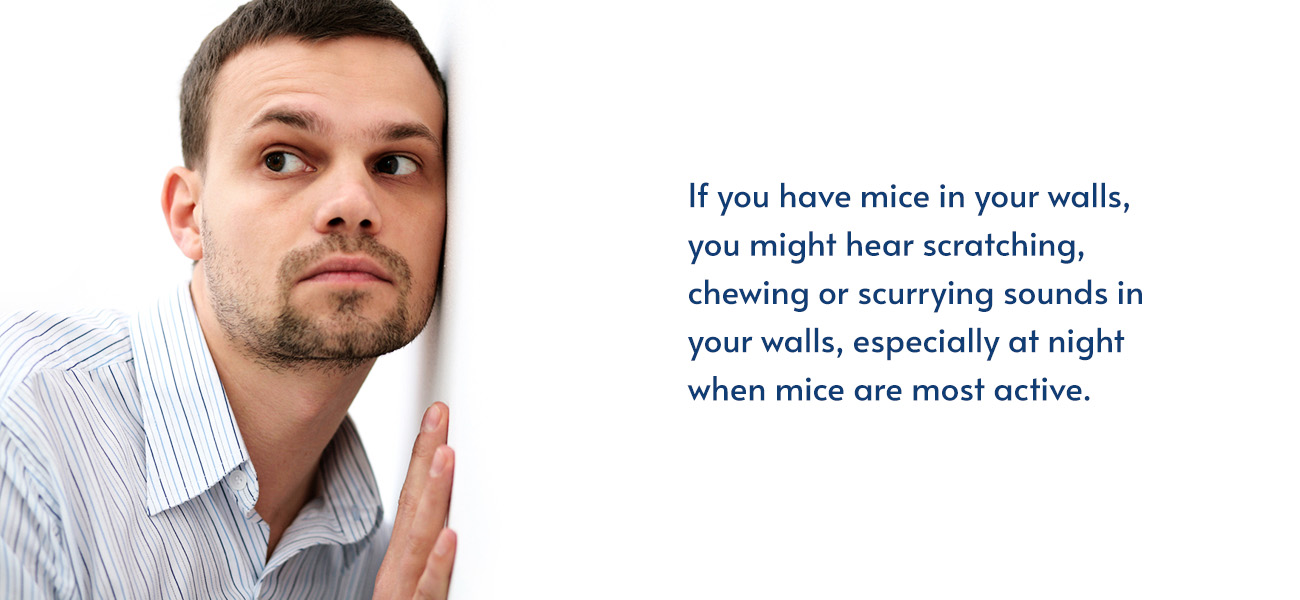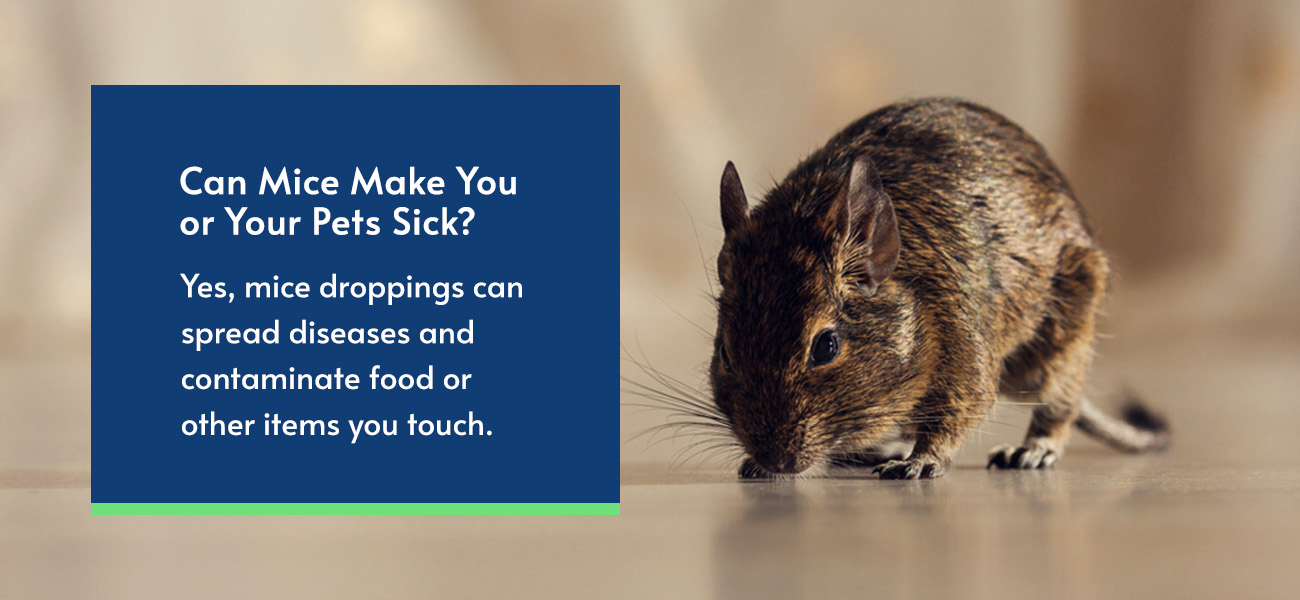Chapter 2: Signs of Mice

Have you found little brown pellets in the bottom of the bread drawer? Typically, the first sign of a mouse issue is droppings in kitchen drawers or cabinets, but no mouse infestation is exactly the same.
Knowing what to look for can help you identify the type of pest you have in your home. This knowledge will also help you discover rodent hiding spots and entry points, so you can seal up your home and keep mice away.
In this chapter, we’ll show you how to determine if you have a mouse infestation. We’ll talk about the common signs of mice, how to clean up after mice and what to do if you discover an infestation.
Signs of Mice in the House
The first step to tackling a mice infestation is to investigate. An investigation will help you determine what kind of rodents you have, the population size and the infestation location. As you explore the inside and outside of your house, you’ll also look for possible entry points and items that may be contributing to the mouse problem, such as debris piles or food crumbs.
To start your investigation, grab a powerful flashlight and head to rooms that contain food or are located above, below or next to a kitchen or food storage area. Common signs you have mice include:
- Grease marks along walls and baseboards
- Mouse tracks on dusty surfaces
- Droppings in the kitchen, attic, garage, basement, utility closet or anywhere near food sources, mouse shelters or pathways
- Food packages with holes or gnaw marks
- Nests are made of shredded paper, fabric or insulation and hidden in utility closets, garages, basements or attics
- Food crumbs left behind by mice
- Live or dead mice
- Mouse hairs
- Sounds of mice living inside walls or cabinets
- Holes in walls, floors and ceilings or under cupboards or cabinet bases
- Scavenger insects that feed on dead mice
- A stale odor emitting from hidden areas
If you have cats or dogs in your home, they may react to areas in a wall or floor where mice are present and help point you in the right direction. While your pet should not be left to tackle your mice problem alone, especially because of the various health risks, your pet can be a great tool in identifying mice infestations before the problem worsens.
Some dog breeds, including Russell Terriers, Dachshunds and Jagdterriers, are known to hunt down and eliminate pests and rodents. Cat breeds such as Siamese, Maine Coon, Siberian and more are also talented in catching mice.

Where to Look for Signs of Mice
Do you suspect you have mice, but you’re not sure of the telltale signs? Mice infestations can start small and quickly spiral out of control once they start breeding inside your house.
If you find any of the following indications, you likely have mice cohabitating in your home:
- Droppings: One of the most distinct signs of mice is droppings. Mice droppings are commonly found near food storage areas such as drawers and cupboards or under sinks. High volumes of droppings often indicate the nest is nearby.
- Gnawing: Mice can chew through food packaging and even your walls. New wall gnaw marks will be lighter in color, and they will darken as they age. If you consistently notice light gnaw marks, this is a sign you have an active infestation on your hands.
- Foul odors: Your pets may notice the smell before you do, but mice will leave an unpleasant odor from their urine. Large infestations can also create stale ammonia smells.
- Tracks: As mice move around your home, they’ll leave behind tracks, including footprints, smudge marks, urine stains or droppings. If you’re unsure what you see are mouse tracks, lay down a thin layer of baby powder. If you do have mice, you’ll see more distinctive tracks in the powder.
- Nests: Mice will use shreds of fabric and paper or dried plant matter to create their nests inside your home. If you find a pile of these materials, it’s likely mice have made themselves at home in your walls, basement or attic.
In addition to the list of signs above, you may also hear mice before you see them. If you have a severe infestation, it’s common to hear rodents make a range of noises when looking for food at night. Mouse noises usually consist of squeaks, fighting sounds, gnawing or clawing. You may also hear them scrambling in the walls or squealing in their nests.
How to Find Where Mice Are Nesting
Discovering the location of a mouse nest can help you get rid of these intruders faster. If you’re finding clear signs of mice, including droppings or gnaw marks, you’re probably close. Mice typically forage only 10 to 25 feet from their nest, but this distance may be even shorter when their nest is next to adequate food supplies.
Common nesting spots for mice include:
- Basements
- Attics
- Cabinets and drawers
- Ceilings
- Flooring
- Walls
- Appliance motor compartments
Mice only need a hole the width of a pencil to infiltrate your home. Yes, mice can squeeze into 1/4-inch-sized holes, meaning they see any holes in your home as an open invitation. If you notice these holes and any of the mice infestation warning signs, it’s likely mice are nesting near this hole.
After a professional mice extermination service, stay vigilant and promptly seal any gaps or holes in your home to prevent another infestation. This includes checking around all electrical, gas, water and sewer lines, behind appliances and around vents.

How to Tell If There Are Mice in Your Walls
If you have mice in your walls, you might hear scratching, chewing or scurrying sounds in your walls, especially at night when mice are most active. To confirm rodents are hanging out in your walls, you can put a stethoscope on the wall to listen to their activity. Since mice can squeeze through tiny holes, it’s easy for them to get inside the walls through cracks and gaps.
While it’s easy for mice to get into your walls, they also enjoy the warmth of the inside of your walls. Plus, it provides them with a dark, safe place to move around and search for food. Mice are also great climbers, which means they can even move up and down along your walls. The safety and comfort of being inside walls make them the ideal place for mice to nest.
How to Tell If You Have Rats or Mice
If you notice droppings, foul odors and gnaw marks in your home or business, there are two possibilities — either you have mice or rats. How can you tell the difference?
While these two pests leave similar signs, they have several distinctions. Identifying what pest you’re dealing with is important for choosing the best course of action and eliminating the infestation.
Some of the most noticeable differences between mice and rats include appearance, droppings and gnaw marks.
Appearance
If you see a rodent in your home, a few distinctive characteristics can help you determine if it is a mouse or rat. Rats are much larger than mice, with mature rats sizing up to 11 to 19 inches long and 1/2 to one pound in weight. Meanwhile, mice are only about three to four inches long and weigh around 1/2 to one ounce.
Rats and mice also have different coloring. Rats have coarse black, gray, brown or red fur, while mice have fine gray, brown or black fur. Mice are also known for their large ears and small black eyes.
If you see a rodent’s tail as a pest scurries out of sight, it can also give clues to what rodents you’re dealing with. Mice tails are fairly small and often have fur on them. By contrast, rat tails are often completely hairless and as long as the entire rat’s body.
Droppings
Since rats are much larger than mice, their droppings are also bigger. Rat droppings come in around 1/2 inch or larger, while mice droppings are smaller and pointed on both sides.
While mice tend to poop wherever they are eating, rats choose one place to use as a litter box. If you find a lot of droppings in one single area, you may be looking at a rat infestation.
Gnaw Marks
Mice leave behind small, clear-cut, gnawed holes that are typically around the size of a dime. On the other hand, rats cause large holes with rough, torn edges because of their larger, more powerful teeth.
Because rats are larger than mice, they can also reach up higher to chew holes in containers. They can cut through materials faster than mice, which have smaller teeth and less powerful jaws.
What Does Mouse Poop Look Like?
Mouse droppings are smooth, pellet-shaped and pointed at both ends. You might compare them to dark grains of rice. Fresh mouse poop is soft and moist but will become hard and dry after a few hours. Droppings are about 1/8 inch to 1/2 inch in length.
Finding mice poop is a key sign mice are active in your home. Mice defecate a lot throughout the day and leave little pellets wherever they go. Deer mice and white-footed mice like to use their nests as bathrooms, leading to a strong odor in a few weeks.
A mouse might leave a few small pellets in an area they recently visited. Daily, a mouse leaves between 50 and 75 droppings. Mice nibble all day long, which leads to a great fecal output. They may also leave droppings to mark their territory.
Although it’s an unpleasant discovery, mouse poop can help you figure out where mice live in your home. The number of droppings you find can also help you determine the size of the infestation.
Sometimes using droppings to determine the type of rodent in your home isn’t always easy. That’s because droppings vary with diet and the age of the rodent. For example, baby rats leave droppings similar to adult mice. This makes things a little more challenging, but not anything a pro can’t handle.
What Do Mouse Urine Stains Look Like?
As mice do not have a designated bathroom spot, they dribble as they travel. Therefore, unless urine has accumulated on a frequently traveled runway, you may not be able to see urine stains with the naked eye. However, you can try to detect urine stains with ultraviolet (UV) light.
If you hold a UV light over a frequently traveled pathway, fresh urine will appear bluish-white and old urine will be a yellowish color. Typically, mice leave droplets of urine in a straight line, usually starting with large drops leading to smaller ones. Urine is often found in nesting or feeding areas or anywhere mice frequently visit.
When mice nest in your home, they use your bathroom and kitchen as water sources. Mice drink the condensation around bathroom or kitchen sink pipes. They may also help themselves to your pets’ water bowls. Just like humans, mice need an adequate water supply to survive, so they will get crafty to find these water sources. They may even drink water from overwatered plants if necessary.
While mice need water to survive, they only need very small amounts. In fact, mice can survive on the amount of water found in various foods if necessary. Although they drink very little water, mice frequently urinate, so searching for mouse urine is a way to determine if an area has a lot of rodent activity and is a good place to set traps.

Can Mice Make You or Your Pets Sick?
Yes, mice droppings can spread diseases and contaminate food or other items you touch. According to the CDC, mice directly spread diseases such as:
- Lymphocytic choriomeningitis (LCM)
- Salmonellosis
- Hantavirus pulmonary syndrome
- Monkeypox
- Rat-bite fever
- Sylvatic typhus
Of course, this list is not exhaustive, and mice carry several other diseases. It’s important to note that mice spread diseases both directly and indirectly. Direct contact with mice includes:
- Touching contaminated materials and then touching the eyes, mouth or nose
- Breathing in contaminated air
- Being scratched or bitten by a mouse
- Eating food contaminated by an infected mouse
- Contact with mouse droppings
Meanwhile, indirect contact with mice includes being bitten by ticks, fleas, mites or mosquitoes that have previously fed on an infected rodent.
Threats to Your Pets
Mice are health threats to you and your family, as well as your pets. Your pets have a natural instinct to kill mice and other rodents, so it’s likely they may kill or even eat a mouse that crosses their path.
If your pet ingests a mouse, they may become infected with Toxoplasmosis or roundworms, which are intestinal parasites. Pets can also suffer from the diseases listed above, and they may even spread these diseases to you and your family.
Hiring a professional pest control service can help you protect your pets from being exposed to mice and the diseases they can carry. Acting quickly is important since mice can reproduce and spread fast.
How to Clean Up Mouse Droppings and Urine
Since mice droppings can transmit diseases, the CDC recommends taking precautions when cleaning up after mice. Here’s how you should handle mouse poop according to the CDC:
- Before cleaning, ventilate the area by opening the doors and windows for at least a half-hour.
- Wear rubber, vinyl or latex gloves to remove droppings.
- Spray the droppings with a disinfectant and let them soak.
- Pick up the droppings with a paper towel and throw them in the trash.
- After you remove the droppings, disinfect any items that may have been contaminated.
- Finally, clean and disinfect the entire area where the droppings were found.
- Remove your gloves and wash your hands with soap and water.

Tips to Prevent Mice in Your Home
You can do a lot to prevent mice from entering and taking up residence in your home or business. Like other pests, mice seek food, shelter and a safe place to reproduce. If you can deny them these basic needs, they’ll look elsewhere for a long-term home.
Here are some practical prevention tips to keep mice from entering or staying in your property:
- Ensure your outdoor trashcan is sealed
- Seal cracks or holes in walls, fireplaces, doorways and more
- Store food in glass or hard plastic containers
- Avoid storing food on the floor or floor-level cabinets
- Routinely dispose of spoiled foods
- Immediately take out trash that includes spoiled foods
- Fix any water leaks in your plumbing
Sometimes, making food difficult to access isn’t enough. Mice may find a crack in the wall you didn’t see and make their way inside for shelter. If you’re concerned there may be mice in your home, reach out to a trustworthy pest control service.
Let Pestech Handle Your Mice Infestation Problems
If partying mice keep you and your family up at night, it’s time to put your foot down. Let us know at Pestech Pest Solutions if you need professionals to intervene. We can help you handle your mice or rat problem.
At Pestech Pest Solutions, we’ve been serving families and businesses in New York State for over 25 years. Contact us today to learn more and get started with rodent control!

